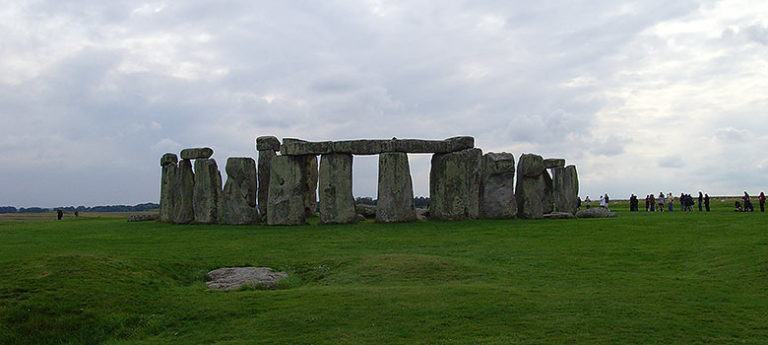Stonehenge, England: The Ancient Circle of Mysteries & Legends
© KarmaWeather by Konbi - All rights reserved
Cover picture by hotzeplotz (source, license) Changes: framing
Stonehenge, The Ancient Circle of Mysteries and Legends
In the open plains of southern England, Stonehenge stands as a testament to human ingenuity, a place where history intertwines with myth and the celestial. With massive stones arranged in a circular formation, Stonehenge has puzzled and fascinated historians, archaeologists, and visitors alike. Some view it as a sacred site, others as an ancient observatory aligned with the solstices, but all agree on its mystique.
Built around 4,500 years ago, Stonehenge’s origins are shrouded in mystery, with theories of its purpose ranging from ritual ceremonies to astronomical alignments. Each stone, each carefully positioned line, reveals glimpses of a civilization that sought connection with the universe and the passing of time.

© Andy Powell (source) License
The story of Stonehenge unfolds as far back as 3000 BCE, with evidence of human activity on the Salisbury Plain. Its iconic stone circles were raised during the Neolithic period, embodying a monumental effort and profound understanding of both stonecraft and astronomy. Stonehenge’s significance continues to draw people from all walks of life, capturing the world’s imagination with its mysterious beauty and alignment with the heavens.
Today, Stonehenge invites visitors to ponder its ancient secrets and immerse themselves in the ambiance of England’s prehistoric era. Standing amidst these timeless stones, one can almost sense the whispers of the past and the vision of those who labored to create it.
History and Geography
Stonehenge, located on England’s Salisbury Plain, is one of the world’s most famous prehistoric monuments. Built over several phases, the structure began around 3000 BCE as an earthwork enclosure before evolving into the iconic stone circle that endures today. Enormous stones, some weighing as much as 25 tons, were transported over great distances, possibly from quarries in Wales, reflecting a high degree of planning and communal effort.
Stonehenge’s alignment with the solstices is one of its most captivating features, drawing people each year to witness the sunrise on the summer solstice and the sunset on the winter solstice, when the stones align with the movements of the sun. Positioned amidst the rolling hills of the plain, the monument not only marks an incredible feat of ancient engineering but also serves as a link to England’s deep, enigmatic past.
Planning a Visit to Stonehenge
Stonehenge is accessible from nearby towns and cities, including Salisbury, which is about 15 kilometers away. Visitors can arrive by car, bus, or train, with a designated visitor center providing information, exhibits, and shuttle buses to the site. The nearby visitor center also offers a fascinating glimpse into Stonehenge’s history with reconstructed Neolithic houses and interactive displays.
- Address: Stonehenge Visitor Centre, Amesbury, Salisbury SP4 7DE, England
- Phone: +44 0370 333 1181
- Entrance fee: Ticketed entry (admission includes access to the visitor center)
- Opening hours: Open daily, hours vary by season
- Catering: Café on-site offers local refreshments, including traditional pastries, tea, and coffee
Stonehenge Facts
The Trilithons
Bluestones and Sarsen Stones
Astronomical Alignment
The iconic trilithons, with two upright stones supporting a horizontal lintel, are perhaps Stonehenge’s most recognizable feature. Constructed using an interlocking system, these stones reveal the sophisticated techniques employed by ancient builders to create a stable and lasting structure.
Stonehenge is composed of two primary types of stones: the smaller bluestones, transported from Wales, and the larger sarsen stones, sourced locally. The origin and transportation of these stones have long been subjects of research, reflecting the impressive reach and effort involved in creating the monument.
Stonehenge’s alignment with the summer and winter solstices is one of its most striking features. This alignment has led many to theorize that Stonehenge served as an ancient observatory or calendar, marking the passage of time and the turning of seasons.
Legends and Cultural Significance of Stonehenge
The Myths of Merlin and the Giants
One of the most ancient legends of Stonehenge involves Merlin, the mythical wizard associated with King Arthur, who is said to have transported the stones from Ireland. Another story claims that giants erected the stones, imbuing the site with a supernatural aura that persists in popular imagination.
Modern Spirituality and Festivals
Today, Stonehenge is a focal point for modern spirituality and is particularly popular with neo-druidic and pagan groups. Each year, people gather to celebrate the solstices, viewing the stone circle as a place of peace and renewal. This enduring reverence for Stonehenge’s spiritual energy continues to draw people from around the world.
Planning a Trip to England and Stonehenge
Located just over an hour’s drive from London, Stonehenge is a must-see for those exploring England’s historic landmarks. Visitors can take advantage of nearby Salisbury’s accommodations and dining options, offering a charming stay in one of England’s most picturesque towns. The region also features other Neolithic sites, such as Avebury and Woodhenge, providing a fuller experience of England’s ancient history.
The nearby town of Salisbury, with its medieval cathedral and charming streets, is an ideal base for those visiting Stonehenge. The town blends historic architecture with modern amenities, making it an inviting spot for travelers who wish to experience both England’s history and hospitality.
Salisbury
Known for its stunning Salisbury Cathedral and lively marketplace, Salisbury provides a delightful stay for visitors to Stonehenge. This historic town offers a mix of cozy pubs, traditional English inns, and boutique shops, enhancing the experience of a journey through England’s cultural heritage.
England’s Chinese Zodiac Animal Sign and Compatibility
|
According to the Chinese zodiac, the United Kingdom is represented by the sign of the Fire Pig, symbolizing warmth, generosity, and resilience. Travelers born under compatible signs—Pig, Rabbit, and Goat—may find a unique connection to England’s landscapes, welcoming culture, and historical depth. In contrast, those born in the Year of the Snake might find aspects of England’s history and customs challenging, though patience and curiosity can reveal hidden charms.
